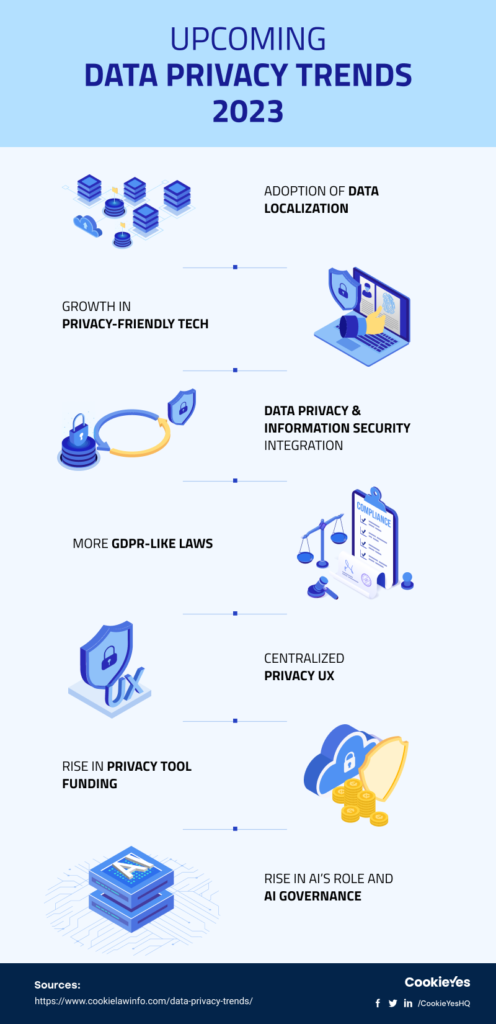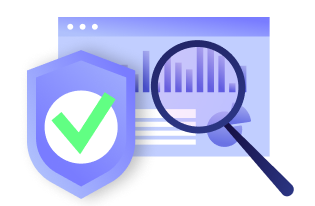Privacy, a basic human right that we tend to demand in all aspects of our life, is becoming increasingly vulnerable in the world of ever-evolving technology and big data. Consumers are demanding more transparency and secure practices when it comes to their personal data collection. Nations worldwide are adopting privacy laws to secure the rights of their citizens; thus, with this evolution of privacy law regulations, companies need to adopt effective practices to combat the challenges of protecting personal data. This article discusses the top data privacy trends to look forward to this year.
7 upcoming data privacy trends
1. Adoption of Data Localization Planning
As data privacy laws emerge and compliance becomes a challenge, companies face the conundrum of how to manage security practices under the uneven regulatory landscape. When designing cloud services, data localization will be a top priority.
2. Technology to address privacy requests.
As consumers become more aware of data privacy, so is the number of privacy requests. An organization’s reputation is rooted in its transparency and responsiveness to those requests. Thus, more organizations are adopting technologies that will help them respond faster to privacy requests.
3. Integrating Data Privacy Management and Information Security Management
As privacy and security share common interests and responsibilities, organizations are adopting strategies that enable them to comply with both data privacy and information security standards. As a result of increasing pressure from regulations worldwide, this single tool-driven integration will aid organizations in complying with both data privacy and information security standards.
4. GDPR flaring up worldwide privacy regulation.
The advent of a comprehensive privacy law like GDPR has flared up the global trend of countries adopting concrete privacy regulations. Many countries have adopted similar laws, and others are considering the same. Therefore, organizations are expected to adopt strategies to comply with GDPR. The application of GDPR is both broad and flexible; as such, it can be implemented in a variety of ways.
5. Integrated or centralized privacy user experience
The consumer tends to reach out to companies that are more transparent and user-friendly. A centralized privacy user experience (UX) refers to the integration of notices, cookies, consent management, and subject rights requests into one single service gateway. This integration will benefit consumers by having better access to their data. Moreover, it is convenient for the employees of the organization and it saves the cost.
6. The increased role of AI in data protection and its governance
The rise of AI in almost every aspect of human life is both a blessing and a curse when it comes to data privacy. AI can indefinitely help organizations to ease their burden of compliance by identifying issues and threats and preventing them. However, AI in data privacy is not as developed as in other fields, and it will take time for us to fully automate the process.
AI is a blessing in disguise when it comes to automated data processing. In recent years, we have seen that around 40% of organizations have experienced data breaches. Governments across the globe are adopting stricter laws in relation to Artificial Intelligence and Machine Learning, which highlights the need for AI governance. Without it, toxic data cannot be identified and addressed.
7. Greater Investment in Privacy Technology
With increasing regulations, there will likely be a significant increase in investment in privacy technology. Organizations will likely utilize these tools to better handle customer data in a secure manner. These tools can be used for improved encryption, anonymization, management, refining, sorting, and tracking of existing data. This will make compliance with data privacy regulations easier for organizations.
Why is it necessary to adapt to these data privacy trends?
Adopting uniformly accepted data privacy management mechanisms
As legal regulations are being adopted globally, companies are forced to adopt strict measures to comply with these data privacy regulations. The uneven regulatory landscape has rendered it necessary for companies to plan and strategize so that they can comply with the majority of these regulations.
Heavy fines for non-compliance
These regulations enforce stricter penalties and more fines. As per the provisions of the California Consumer Protection Act, organizations are fined up to $7500 for intentional violations. Likewise, we have seen big companies like Amazon, Whatsapp and so on, pay a huge sum of around €100 million to €746 million as fines for non-compliance with the provisions of GDPR in 2021. This will force companies to improve and update their privacy compliance mechanisms as per global trends.
Boosting the brand value and business
In the research done by Gartner, it was shown that consumers will buy products from companies due to Data Privacy. Consumers prefer businesses that are transparent, accessible and responsive. Going with the global trend; adopting the latest technology and data privacy compliance tools; making the user experience seamless and feasible and so on will improve the brand value of the company. This will enhance the trust and brand faith among the consumers.
Protecting personal information
As technology advances, so do the ways in which personal information can be accessed and used. It is crucial for companies to adapt to the latest data privacy trends to ensure that personal information is protected from breaches, cyber-attacks, and unauthorized access. This not only protects the consumers’ personal information, but it also protects the company from legal and reputational repercussions.
Building customer loyalty
By adapting to data privacy trends, companies can demonstrate to their customers that they value their privacy and are committed to protecting their personal information. This builds trust and loyalty among customers, which is essential for long-term business success. Customers are more likely to continue doing business with a company that they trust to protect their personal information.
In conclusion, it is important for companies to stay updated on the latest data privacy trends and implement them to ensure the protection of personal information and compliance with regulations.
12 Steps to adapt to global data privacy trends
- Adopt a privacy management framework.
- Integrate data privacy principles into the company at all physical, administrative, and technological levels.
- Make products and product lifecycles follow privacy by design and default.
- Formulate and adopt data privacy and information security policies.
- Engage more data privacy professionals and expand the role of a data protection officer.
- Educate employees to adopt data privacy principles.
- Utilize privacy technology for uniform and seamless compliance.
- Adopt an effective consent management platform.
- Emphasize regulation and third-party risk management.
- Offer data protection as a service to customers. Be transparent, accountable, and responsive.
- Create a centralized, consumer-friendly experience using a single portal for notices, cookies, consent management, and subject rights requests.
- Adhere to global privacy laws, such as GDPR, and take proactive steps to ensure compliance.
Challenges faced in the data privacy management
- The complexity and complication of the process due to a large amount of data, reliance on manual work, and a lack of automated systems.
- The increased risks caused by a lack of awareness within the organization, with 82% of 2022 data breaches being attributed to human error according to Verizon.
- The potential for too much access being granted to third parties and a lack of proper third-party risk management systems.
- The need for a proper consent management system and a people-centric approach.
- The high cost of adopting and maintaining the latest technology and data privacy frameworks across the organization.
- The difficulty of keeping up with the numerous regulations and making the compliance process consistent.
- The lack of effective channels for dealing with and preventing data breaches.
Frequently Asked Questions
What are the five big data privacy risks?
- Inadequate data breach response
- Consent on anything and everything
- Non-transparent policies, terms and conditions
- Dangerous web application vulnerabilities
- Insufficient deletion of personal data
How important is GDPR compliance?
GDPR compliance is highly essential for companies as it ensures the privacy rights of individuals are upheld and protects the reputation and brand value of the business.
How can we prevent privacy issues?
Privacy issues can be prevented by:
- Formulating and implementing data privacy management policies and frameworks
- Proper vendor and third-party risk management
- Proper data breach responses
- Employing principles of transparency and accountability
- Following data privacy principles
Which country has the strictest data privacy law?
The General Data Protection Regulation passed by the European Union is considered the world’s most strict data privacy law, with a large scope and significant penalties.
What is the future of data privacy?
The future of data privacy includes:
- More countries implementing data privacy regulations
- Portable data ownership with individuals
- Use of Artificial Intelligence and Machine Learning in data privacy
- Improved cybersecurity
- Greater transparency and protection of consumer privacy rights
What are data privacy tools?
Data privacy tools are tools used to protect and safeguard individuals’ personal data, such as:
- Data Loss Prevention Software
- Malware detection tools
- Data Encryption Tools
- Encryption tools
- Identity and Access Management tools
- Consent management tools
- Compliance assistance tools
- Policy generators








